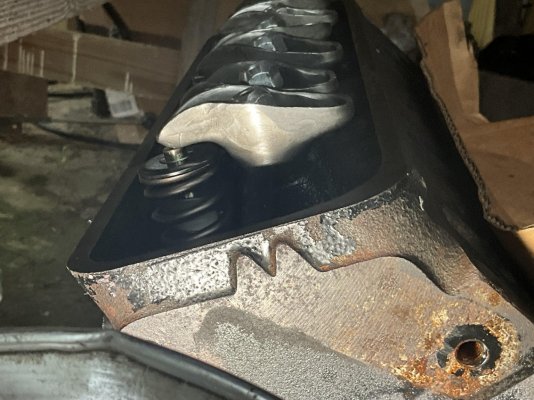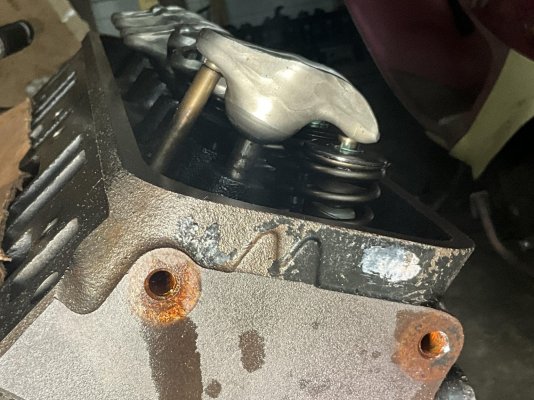There is something that I'm not getting. If
A. The stock distance from the top of the piston to the block deck in a SBC is .25-.26
B. The desired quench (from top of piston to bottom of head) = ~ .040
=> Wouldn't the stock engine require a .015 head gasket?
The stock engine wasn't built with quench in mind.
Sure it was. The engineers who designed engines knew about quench/squish. There were problems later that caused..."bad decisions"...on multiple levels and from several parties. The primary being that in the early emissions-control days, the engineers got all scared about the hydrocarbons trapped in the "crevice volume"; and so they kinda screwed-the-pooch removing quench. Mopar, and Buick small-block made totally-open chambers for some applications, no deliberate quench at all. Buick big-blocks have the piston so far down the hole it's unbelievable. BBC went from "closed chamber" heads with quench on both sides, to "open chamber" heads with quench only on one side, and everyone went to composition head gaskets partly due to crappy, high-speed machining, partly to better-accommodate warpage, partly because of "lightweight" castings that had a history of cracking, maybe for other reasons.
Point being, if you remove quench, the chamber burns all the way across, and there's far less unburned hydrocarbons trapped in the remaining crevice volume. Problem is, you get a crappy, lazy burn that requires a heap of spark advance and promotes excess wasted heat. It was a bad trade-off, but that's the compromise that was chosen. Don't blame me, they didn't ask my permission.
Go back in time far enough, and you'll find shitloads of 265, 283, 307, 327 engines all built with ~.015 steel shim gaskets just like what Fel-Pro is selling, except without the rubbery coating. They were bare steel, installed with "sealer" which--often as not--was "aluminum" spray paint. I'm not sure the SBC came with
any other head gasket besides the embossed steel shim prior to the 350 in '67. Steel shim gaskets may or may not have been used after that. I just don't remember.
Same deal for BBC--the first of 'em--396, 427--were made with a BBC version of the steel shim gasket. Same deal--had to apply some kind of "sealer".
Oldsmobile used steel shim gaskets.
Buick used steel shim gaskets.
I'm not sure about Pontiac or Cadillac. I suspect that the same kind of steel shim gaskets were used in some applications by Mopar, Ford, and maybe AMC, but I have no experience there.
Steel shim gaskets went out-of-favor, which is a damned shame. They were dirt-cheap, and preserved quench. OTOH, they resulted in stock-replacement piston manufacturers sabotaging piston compression height, because if you decked a block to clean-up warpage, rust, or any sort of scarring, even a .010 skim-cut would reduce the quench distance from .040 to .030 nominal, maybe less depending on production-line machining variations. Yeah, the machining was even worse in the '50s to the '70s. At some point the piston hits the head and causes grief--so the piston people dropped the piston even farther into the hole to prevent warranty claims.
And then .040 composition head gaskets got popular. Folks who never had problems with quench/squish and therefore never understood how important it is...suddenly had NO quench/squish. And we blamed the piss-poor performance on "smog controls" because it's easy to blame stuff you can see instead of understanding what's actually happening.
I'm not saying that early emissions control devices didn't hurt power. I'm saying that they didn't hurt power as much as folks think they hurt power; the real problem(s) were buried deeper than just an EGR valve and AIR pump.
Thousands of years ago (certainly in the prior century) I contacted Mr Gasket about buying a run of steel shim gaskets for Olds and Buick and such. They told me they would not make a production run of them for me, but they would sell me the male and female stampers. Well, yeah, that's fine, but there's more to making the gaskets than just the stampers. I passed.

 www.summitracing.com
www.summitracing.com




